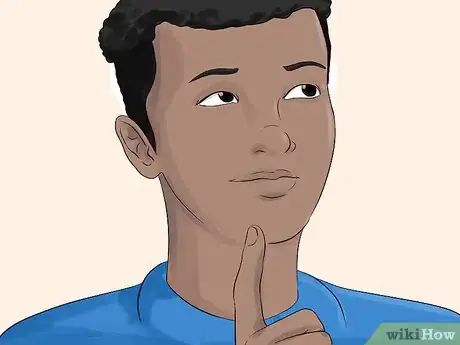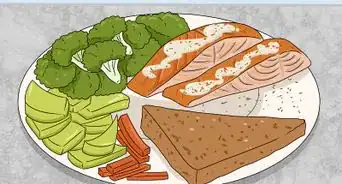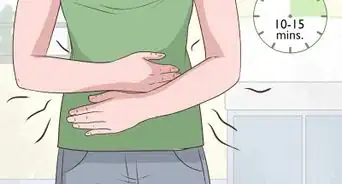This article was co-authored by Sari Eitches, MBE, MD. Dr. Sari Eitches is an Integrative Internist who runs Tower Integrative Health and Wellness, based in Los Angeles, California. She specializes in plant-based nutrition, weight management, women's health, preventative medicine, and depression. She is a Diplomate of the American Board of Internal Medicine and the American Board of Integrative and Holistic Medicine. She received a BS from the University of California, Berkeley, an MD from SUNY Upstate Medical University, and an MBE from the University of Pennsylvania. She completed her residency at Lenox Hill Hospital in New York, NY and served as an attending internist at the University of Pennsylvania.
This article has been viewed 417,165 times.
Sometimes we eat when we’re upset, bored, or distracted, even when we’re not actually hungry. The good news is that by being more mindful of your hunger cues and learning to pause and assess before giving into cravings, you can start eating in a more intuitive, balanced way that helps fuel your body without leaving you feeling full or sluggish. We’ve put together some tips below to help you get started!
Steps
How to Know if You're Hungry
-
1Take a "self scan." Before eating any meal or snack, take a minute or two to do a self scan. This may give you clues about your hunger level and desire to eat.[1] Think about:
- Your level of hunger. Are you starving? Are you full? Are you satisfied?
- Take note of any physical signs of hunger. Your stomach may be growling, you might feel an "emptiness" in your stomach or you might feel hunger pangs with physical hunger. You may feel irritable or have a headache.
- If you feel like you might be craving food without being physically hungry, assess your emotional status. Are you bored? Did you have a stressful day at work? Are you tired or fatigued? Many times these emotions cause us to feel "hungry" when in all reality, we are not.[2]
- Sometimes you might think you're hungry when you really just need a distraction because you're bored. Try getting up and stretching, making a phone call, or going for a walk.[3]
-
2Do the apple test. This is a simple test that can help you figure out if you're experiencing physical hunger or emotional/head hunger. In general, emotional hunger is a craving or desire for a very specific group of foods (like carbs) or a specific food (like chocolate cake). Physical hunger will be satisfied with a wide array of food options.
- Ask yourself would you still want this snack if it were only an apple, raw carrots or a salad?
- If the answer is yes, go for that apple (or other fruit or vegetable) or other healthy, planned snacks to truly nourish that physical hunger.
- If the answer is no, then the hunger/craving you are experiencing is probably not a physical hunger in your stomach, but instead an emotional hunger.
- If you've determined you're experiencing emotional hunger, this might be a good time to take a walk or take a 10-minute break and reflect on what may be bothering you.
Advertisement -
3Rate your hunger level on a scale from one to 10. Rating your hunger level on a scale may help you determine what to do — have a snack or wait for your next planned meal. Try rating your hunger from one (almost faint with hunger) to 10 (overly full, sick feeling).[4]
- If you're hunger level is around a three or four, it may be time to eat. If your next planned meal isn't for another two hours or more, have a planned snack. If your next planned meal is within the next hour or so, try to wait until your meal to eat.
- Ideally, do not let yourself be at either extreme — starving at a level one or so full you're at a level 10. Fluctuate between a four and seven.
- It's normal and expected to be hungry prior to eating meals and even right before going to bed in the evenings.
Limiting Food When You're Not Hungry
-
1Drink enough water. Aim to drink adequate fluids daily. It's generally recommended to consume around eight 8-oz glasses or 64 oz (2 liters) daily. This is just a general recommendation — you may need slightly more or less. Adequate hydration can help aid in weight loss, but can also help you manage your hunger levels throughout the day. [5]
- Thirst or low-level dehydration can feel like hunger. If you're not drinking enough each day, that dehydration can cause hunger-like feelings that may be triggering you to eat more or more often than you should.[6]
- Keep a water bottle close by and monitor how much you're drinking each day.
- Also, drinking right before a meal can calm your hunger and decrease your overall intake at your meal.
-
2Wait for 10 to 15 minutes. Emotional hunger can come on very suddenly. It's also quicker to go away compared to physical hunger. If you remove yourself from the situation for about 10 to 15 minutes, you may find that your craving or desire to eat subsides or is more easily controlled.
- Waiting a few minutes might not take your cravings away completely, but they may reduce them enough for your willpower to win.
- Try telling yourself that in 10 to 15 minutes, you will revisit your thoughts to eat a certain food or snack. Engage in another activity and come back to your craving if it's still there.
-
3Clean out your kitchen. Having a pantry or refrigerator full of unhealthy, tempting foods can make emotional eating easier to do.[7] If you know you typically reach for a box of crackers or bag of chips when you're bored or stressed, not having those foods around when those emotions hit may help you decrease eating when you're not truly hungry.
- Take an hour or two of your free time to survey your kitchen. Look in your pantry, freezer, refrigerator, or any cabinet/area in your house where you keep food items. Place all tempting foods and snacks on a table to evaluate which foods should stay and which should go.
- Donate unopened foods to a food bank or church if you do not want to throw them in the garbage.
- Make a pact with yourself to not buy or purchase tempting snack foods so you can keep your kitchen and home a healthy environment.
-
4Leave the area. Sometimes, being in the same room with a favorite food or an item you're craving makes it difficult not to consume it.[8] If you're in a spot in your home or office that's adding to your desire to eat, get out of there. Give yourself the time and space to get your mind clear of your cravings.
- Take a walk for 15 minutes if you can. Clear your head and refocus your attention on other things besides your craving or desire to eat.
- Many times, people crave snacks at night.[9] Instead of staying awake and eating, go to bed. You'll be away from the kitchen and won't be tempted to eat mindlessly in front of the TV. If you're not tired, read a good book or a magazine until you're tired enough to fall asleep.
-
5Write a list of activities you can do instead of eating. Journaling ideas that can help distract you from cravings of the desire to eat can help you manage emotional eating.[10] Jot down a list of activities you enjoy or that are distracting enough that they'll refocus your attention away from food. Ideas can include:
- Cleaning out your closets or reorganizing a junk drawer
- Going for a walk
- Engaging in a favorite hobby like knitting, scrap-booking or drawing
- Reading a book or magazine
- Playing a game
- Doing something that requires a lot of brainpower like hard, long-winded maths calculation
-
6Consume a small portion of the food you're craving. Sometimes, cravings or the desire to eat is incredibly overwhelming. Even when you try to distract yourself or give your craving time to subside, it's still very intense. Some experts recommend consuming a small, portion controlled serving of the food you're craving.
- Eating a small portion may help the craving subside while giving you the pleasure of eating something tasty.
- Ensure that you follow an appropriate portion size. Check the food label and measure out your portion, put the food away and then slowly consume it so you can enjoy and savor it.
Managing Emotional Eating
-
1Journal. An emotional eating food journal is a great tool to help you become aware of and manage your emotional eating. You can use it to see where or when you eat and what types of foods seem to be craving or comfort foods. Write down what you eat, when, and how much.
- Also take note of any emotions you may be feeling when you eat. This may help you gain insight into what emotions trigger you to eat certain foods.
- Purchase a journal or download a journaling app on your smartphone. Track as many days as you can — both weekday and weekend days. Many people eat differently on the weekends so including both weekend and weekdays is important.
-
2See a registered dietitian or therapist. These health professionals can help you manage emotional eating. If you're having difficulty managing your eating or it's taking a toll on your health, plan to meet with both a registered dietitian and behavior therapist.
- A registered dietitian is a nutrition expert that can help you understand emotional eating, talk to you about true physical hunger and provide you with alternative food choices. They can even help you create a meal plan.
- A behavior therapist will help you understand why you emotionally eat and give you ideas for changing your reaction or behavior to certain emotional triggers.
-
3Find a support group. No matter what health goal you have, having a support group in place is key for long-term success. This is especially true for emotional eating. Having a support group when you're feeling low or stressed can help you feel more relieved without the use of food.
- Whether it's your spouse, family, friends, or co-workers, a support group are your cheerleaders that will motivate and encourage through your progress.
- Also try finding an online support group or a local group to meet up with. Email new friends that share your long-term goals.
References
- ↑ http://www.helpguide.org/articles/diet-weight-loss/emotional-eating.htm
- ↑ http://www.helpguide.org/articles/diet-weight-loss/emotional-eating.htm
- ↑ Sari Eitches, MBE, MD. Integrative Internist. Expert Interview. 3 April 2020.
- ↑ https://www.health.qld.gov.au/__data/assets/pdf_file/0019/152812/wtmgt_hungerscale.pdf
- ↑ http://www.mayoclinic.org/healthy-lifestyle/nutrition-and-healthy-eating/in-depth/water/art-20044256
- ↑ http://www.mayoclinic.org/healthy-lifestyle/nutrition-and-healthy-eating/in-depth/water/art-20044256
- ↑ http://www.mayoclinic.org/healthy-lifestyle/weight-loss/in-depth/weight-loss/art-20047342?pg=2
- ↑ http://www.mayoclinic.org/healthy-lifestyle/weight-loss/in-depth/weight-loss/art-20047342?pg=2
- ↑ http://www.mayoclinic.org/healthy-lifestyle/weight-loss/in-depth/weight-loss/art-20047342?pg=2
About This Article
To know when you're actually hungry and not just wanting to eat because you're bored or stressed, ask yourself if you'd be willing to eat a salad with a side of fruits and vegetables right now. If the answer is yes, you're probably actually hungry. However, if the answer is no, you might just be craving something sweet or unhealthy. In that case, try distracting yourself with something until your craving goes away. For example, you could read a book, drink a glass of water, or go for a walk. Additionally, if you commonly experience unhealthy food cravings, consider getting rid of any unhealthy options in your fridge and pantry so you're less likely to think about them. For advice from our Dietary co-author, like how to manage emotional eating, keep reading!
-Step-3.webp)




-Step-5.webp)
-Step-6.webp)

-Step-8.webp)


-Step-11.webp)





























































